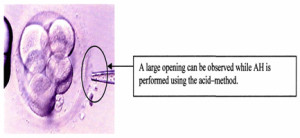How does assisted hatching work?
The existing embryo has to hatch from its outer layer known as zona pellucida before it attaches itself to the wall of the womb. It is medically proven that making a hole or even thinning this outer layer would help embryo to hatch and increases the chances of the woman becoming pregnant. However assisted hatching does not improve the quality of the embryos. Assisted hatching is not recommended as the pregnancy results are very low.
It is medically said that further research needs to be conducted to check and find out whether assisted hatching can have an impact on live birth rates and to monitor the current consequences of children born with this procedure.
What is assisted hatching?
This process is done while the embryo is placed in the laboratory. Before it can be transferred into the womb, a small hole is made in the outer layer of the embryo using acid, laser of mechanical methods.
The procedure is :
Step 1.
When the embryo has fully developed after a period of 3 days, the embryologist uses weak acid in a fine glass pipette, or a micro laser, or micro tool to make outer layer of the embryo thin.
Step 2.
If the embryologist uses weak acid, then the embryo is washed to prevent further damage.
Step 3.
As assisted hatching makes a hole in the outer layer around the embryo antibiotics would be administered to prevent infection.
What is my chance of having a baby with assisted hatching?
There is no guarantee that with assisted hatching, it will increase the chances of pregnancy. It is said that in order women the “zone pellucida” which is around the embryo can appear to be thickened, the weak point in the “zona pellucida, may help in implantation. Medically there is no evidence to prove that it helps in attaining a healthy pregnancy.
If the fertility specialist at the clinic recommends, this procedure, talk with them and find out the pros and cons of this procedure. You do have an advantage if you are younger and using your own eggs, the chances of success could be higher.
Risks of assisted hatching?
- If this treatment is carried out, it can cause abnormality in the baby than IVF. Without this procedure, only the outer layer is affected and the embryo is intact.
- Risk of damage
- If more than one embryo transferred, then this may increase the risk of multiple births.
